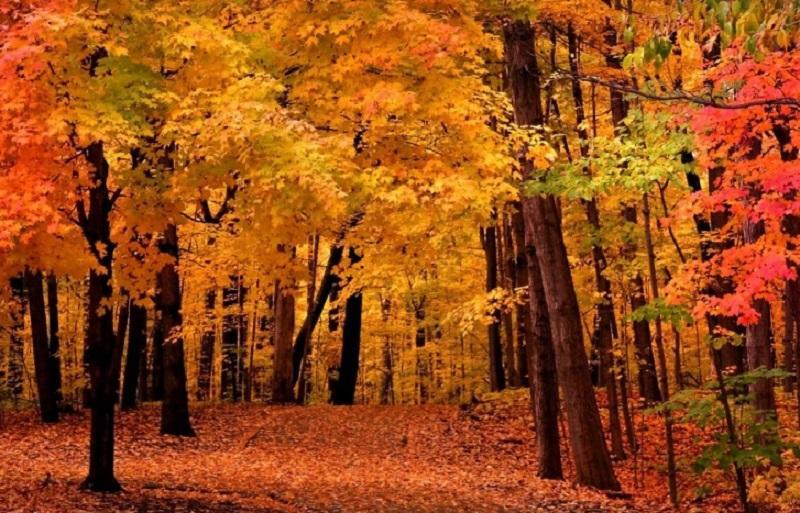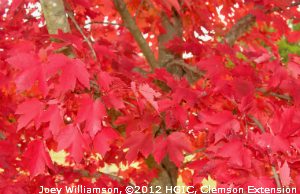What’s Behind Those Fall Colors?
By Gil Medeiros, former Fairfax Master Gardener
 My guess is most of us take this for granted. As fall progresses to dreary winter, we are fortunate to witness the spectacular display of color in fall. We live in one of the few areas of the world where deciduous trees and shrubs put on such a show. A few areas of Europe, China, and Japan have displays of color that rival those that we see in Eastern North America. Fall color is almost nonexistent in the Southern Hemisphere.
My guess is most of us take this for granted. As fall progresses to dreary winter, we are fortunate to witness the spectacular display of color in fall. We live in one of the few areas of the world where deciduous trees and shrubs put on such a show. A few areas of Europe, China, and Japan have displays of color that rival those that we see in Eastern North America. Fall color is almost nonexistent in the Southern Hemisphere.
The pace and characteristics of autumnal color change are dictated mainly by plant genetics, which determine the chemical compounds that the plant makes. Weather contributes to the timing and intensity of the color.
As everyone knows, chlorophyll is responsible for the green color of leaves. Chlorophyll, which uses light, water, and carbon dioxide to produce the sugars that sustain the plant, is an unstable compound. That means it falls apart easily. The plant must produce it continuously to maintain life-sustaining photosynthesis. As days become shorter and temperatures turn cooler, the tree releases a hormone that triggers the development of a membrane between each leaf stem and branch. This is the plant’s first step to prepare for winter. The membranes act as valves that diminish the flow of water and nutrients to the leaves.
As a result, the production of chlorophyll slows and stops. The remaining chlorophyll decomposes quickly. In the absence of chlorophyll, other colorful pigments in the leaves such as carotenoids and anthocyanins, already there, become visible to the eye. This is the magic of fall color change.
Carotenoids are responsible for the yellow and orange colors in plant leaves. Carotenoids, which are very stable, are in the leaves throughout the growing season. The function of this pigment is to help the photosynthetic process by absorbing ultraviolet light and transferring energy to the chlorophyll. In this role carotenoids make photosynthesis more efficient. Carotenoids also protect the chlorophyll from decomposition.

Gingko Leaves
Anthocyanins are responsible for red, blue, and purple colors in leaves. When you are tired of talking politics at cocktail parties, amaze your friends by telling them that anthocyanins are not present in leaves during the entire growing season, as is claimed by many textbooks. Anthocyanins in leaves are produced by plants in late summer when sugars accumulate in the leaves. Some plants convert the sugars in plant sap to anthocyanins — again a function of genetics.
Plants produce high concentrations of sugars in their leaves when weather conditions are just right. Temperatures must be low but above freezing. Rainfall must be limited and sunshine abundant. These conditions stimulate anthocyanin production; this results in more intense red and purple coloration.

Red Maple
By the way, you can amaze your friends again by connecting the anthocyanins of fall leaf color to the dietary benefits of consuming anthocyanins. The beneficial anthocyanins color flowers and fruits in order to attract insects and animals. These compounds are touted for their antioxidant and anti-inflammatory properties, prevention of heart disease, and myriad other claims. But make sure you do not counsel your friends to eat the red leaves of a maple tree in autumn. They may be toxic. You get anthocyanins in your diet from fresh fruits, vegetables, and the occasional swig of red wine, NOT by consuming fallen leaves of shade trees.
When the leaves turn brown, it is because of another class of chemicals called tannins. The leaf tannins perform several functions during the growing season, one of which is to the make the leaf tissue unpalatable for insects and animals. The highly water soluble tannins impart a phenolic smell to puddles and shallow bodies of water where dead leaves have accumulated.
The same membrane in each leaf petiole that caused the demise of the chlorophyll eventually closes completely. This seals off the circulatory system of the tree before winter sets in. It causes the leaves to separate from the tree, drift to the earth, and return their nutrients to the soil. The cycle continues. Winter is almost here.
Resources
Why Leaves Change Color, U.S. Department of Agriculture
The Process of Leaf Color Change, Harvard Forest
Why Leaves Change Color, State University of New York, Environmental Science and Forestry